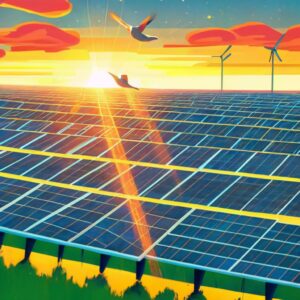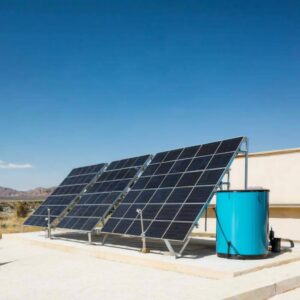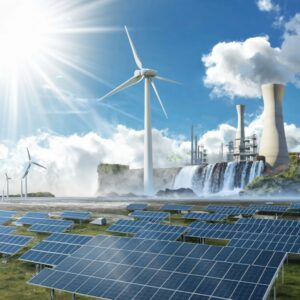
Mastering the Sun: Solar Energy Forecasting and Resource Assessment
Advanced solar energy forecasting techniques utilize cutting-edge technologies and methodologies to improve the accuracy of solar power generation predictions. By incorporating sophisticated algorithms and data analysis, these techniques enable stakeholders to make informed decisions and optimize energy production in real-time.
One of the key factors that advanced forecasting techniques take into account is weather patterns. By analyzing historical weather data and using predictive models, solar energy forecasts can accurately estimate the impact of cloud cover, temperature fluctuations, and other weather phenomena on solar power generation.
“Accurate solar energy forecasting is crucial for efficient grid operations and maximizing the utilization of renewable resources.”
By harnessing the power of advanced forecasting techniques, stakeholders can ensure the efficient integration of solar power into the grid, leading to reduced costs and enhanced grid stability. With precise forecasting, operators can proactively respond to fluctuations in solar power generation, adjusting their energy production and storage strategies accordingly.
Moreover, advanced forecasting techniques empower stakeholders to optimize the utilization of solar energy by effectively managing its generation and consumption. By accurately predicting solar power generation, businesses and households can plan their energy usage more effectively, supplementing conventional energy sources with renewable solar energy and reducing their carbon footprint.
In addition to forecasting, accurate solar resource assessment methods play a vital role in determining the solar potential of a specific location. These methods consider various factors such as geographical location, irradiance levels, shading effects, and rooftop orientation to estimate the amount of solar energy that can be harnessed.
“Accurate resource assessment methods pave the way for strategic decisions regarding solar installations and maximizing solar potential.”
By leveraging accurate resource assessment techniques, stakeholders can identify optimal locations for solar installations, ensuring maximum solar energy capture and efficient use of available land and resources. This data-driven approach facilitates the development of solar energy projects with the highest potential for long-term viability and success.
Solar energy forecasting and resource assessment techniques collectively form the foundation for unlocking the full potential of solar power generation. The integration of advanced forecasting and accurate resource assessment not only enhances grid stability and reduces costs but also paves the way for a sustainable future powered by renewable energy.
Benefits of Advanced Solar Energy Forecasting and Resource Assessment
The benefits of advanced solar energy forecasting and resource assessment techniques include:
- Improved accuracy in solar power generation predictions
- Enhanced grid stability and cost reduction
- Optimized energy production and consumption strategies
- Identification of optimal locations for solar installations
- Maximization of solar potential and resource utilization
- Strategic decision-making for solar energy projects
- Reduction in carbon emissions and environmental impact
By harnessing these advanced techniques and methodologies, we can capitalize on solar energy’s vast potential, creating a greener and more sustainable future for generations to come.
Accurate Solar Resource Assessment Methods
Accurate solar resource assessment methods are essential for determining the solar potential of a particular location. These methods consider various factors, such as geographical location, irradiance, shading effects, and rooftop orientation, to estimate the amount of solar energy that can be harnessed.
By employing accurate resource assessment techniques, stakeholders can identify optimal locations for solar installations and make informed decisions regarding solar energy utilization.
Geographical location plays a crucial role in solar resource assessment. Different regions receive varying amounts of sunlight throughout the year due to variations in latitude, elevation, and local climate.
Irradiance, the amount of solar radiation received at a particular location, is another critical factor in evaluating solar potential. Areas with higher irradiance levels have a greater capacity for solar energy generation.
Shading effects caused by nearby structures, trees, or other obstructions can significantly impact the efficiency of solar installations. Accurate assessment methods take into account these shading effects to determine the optimal placement of solar panels.
Rooftop orientation is also considered in resource assessment. The angle and tilt of a roof can affect the amount of sunlight that reaches the solar panels, thus influencing their energy generation efficiency.
By leveraging accurate resource assessment techniques, stakeholders can uncover the true solar potential of a location and make data-driven decisions about solar energy installations. This leads to more efficient utilization of solar power and contributes to a greener and more sustainable future.

Benefits of Accurate Solar Resource Assessment:
- Optimal placement of solar installations
- Maximized solar energy generation
- Improved return on investment
- Enhanced grid stability
- Reduced carbon footprint
Unleashing the Power of Solar Energy
Solar energy forecasting and resource assessment play a vital role in optimizing the efficiency and integration of solar power generation. By utilizing advanced forecasting techniques, stakeholders can accurately predict solar power generation, promoting grid stability and reducing costs.
Accurate resource assessment methods are essential for identifying optimal locations for solar installations and maximizing the utilization of solar potential. These methods consider various factors, such as geographical location, irradiance, and shading effects, to determine the amount of solar energy that can be harnessed.
With precise solar energy optimization and the implementation of advanced technologies, we have the power to pave the way for a renewable and sustainable future. By harnessing the abundant energy provided by the sun, we can reduce our dependence on fossil fuels and make significant strides towards a cleaner and greener planet.
FAQ
What are advanced solar energy forecasting techniques?
Advanced solar energy forecasting techniques utilize cutting-edge technologies and methodologies to improve the accuracy of solar power generation predictions. These techniques take into account various factors, such as weather patterns, cloud cover, and historical data, to provide reliable forecasts for different timeframes.
Why are accurate solar resource assessment methods important?
Accurate solar resource assessment methods are essential for determining the solar potential of a particular location. These methods consider various factors, such as geographical location, irradiance, shading effects, and rooftop orientation, to estimate the amount of solar energy that can be harnessed. By employing accurate resource assessment techniques, stakeholders can identify optimal locations for solar installations and make informed decisions regarding solar energy utilization.
How do solar energy forecasting and resource assessment contribute to efficient solar power generation?
Solar energy forecasting and resource assessment are crucial components in maximizing the efficiency and integration of solar power generation. Advanced forecasting techniques enable stakeholders to predict solar power generation accurately, promoting grid stability and reducing costs. Accurate resource assessment methods help identify optimal locations for solar installations, making the most of solar potential. By harnessing the power of solar energy and leveraging advanced technologies, we can pave the way for a renewable and sustainable future.








